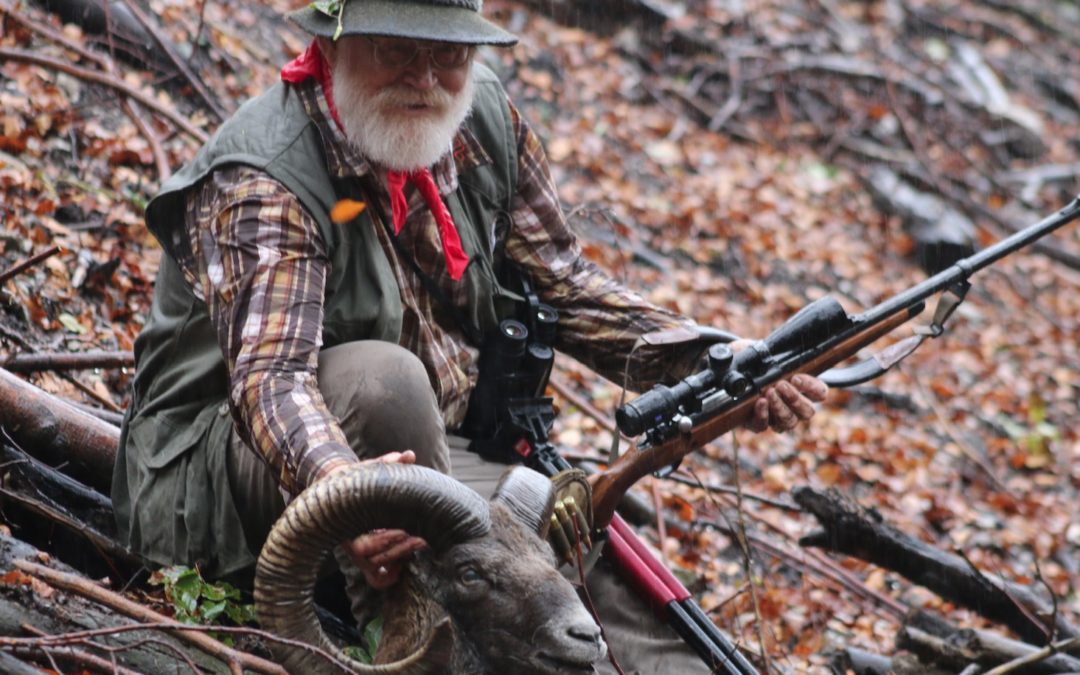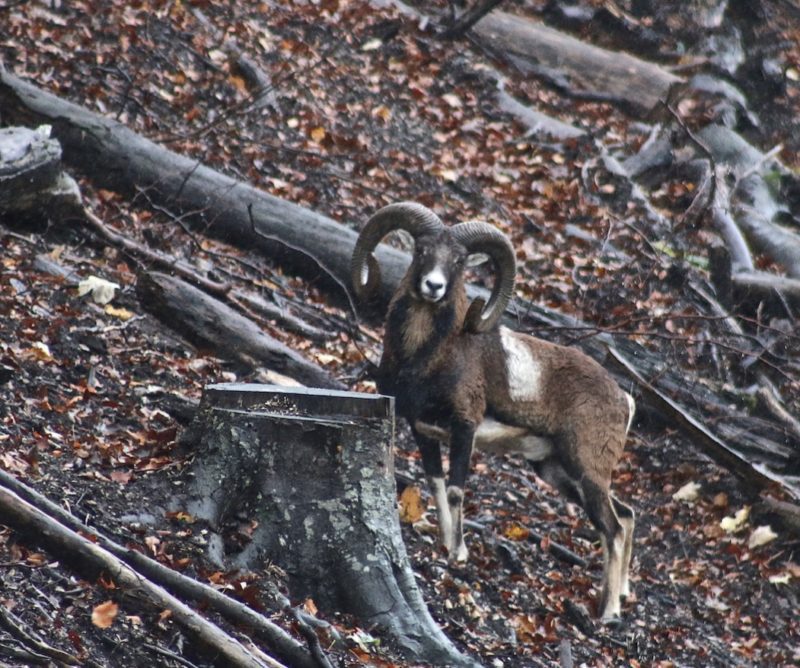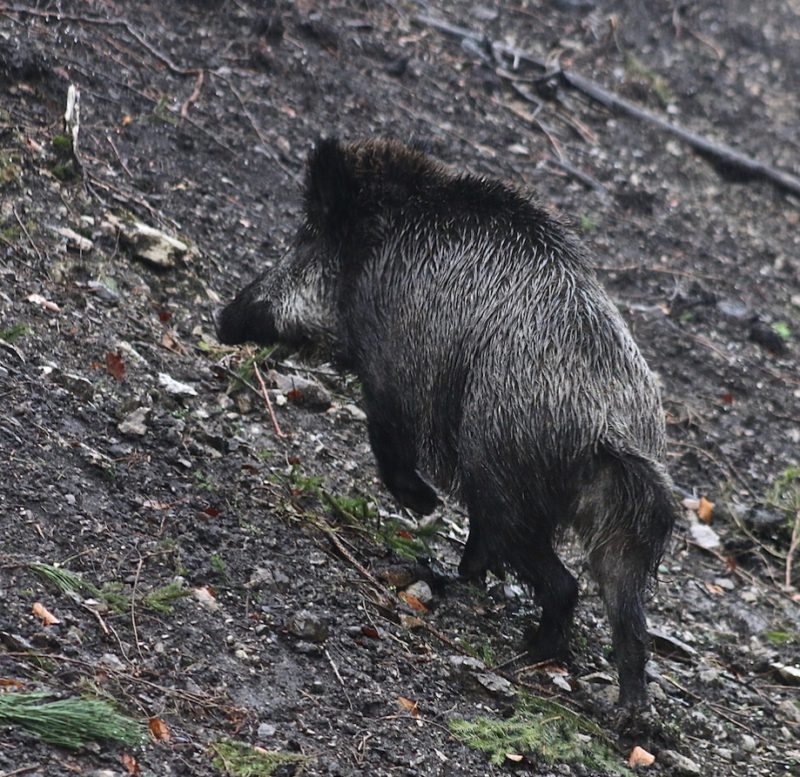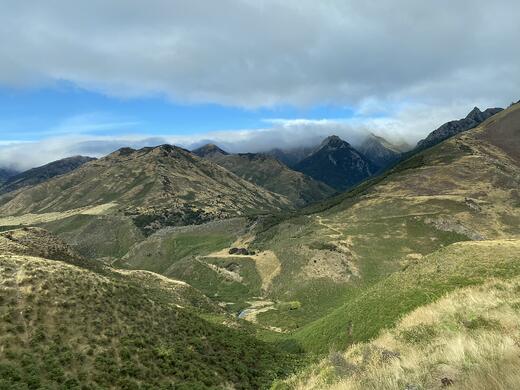It was a lone mouflon ram. And what a ram he was!
“Alten schaft, grossa haerner, gons lonkt. Volns gein! Schnel, aeranz das raegendt!” or something to that effect was what my Austrian guide was saying.
I nodded. With any luck we would catch up with the old mouflon ram before the bottom totally dropped out of the low-hanging clouds. But we might not. It had been a trying though fun-filled hunt. Austria’s Lower-Alps mouflon seemed to be anticipating our every move.
We took off at a brisk walk hoping to catch sight of the small herd of seven or eight mouflon rams on the opposite slope. When we first spotted them, they had been feeding uphill behind a screening of oaks and evergreens. Had it not been for the white “saddles” on their sides I doubt we would have seen them. Thankfully my jaeger had raised his binos in the right direction, glassed them and then tried to find a way we could get closer. Lowering the binos he had explained in German, there was one very old ram that was massive with long full-curling horns. And, we must go quickly before it seriously started raining once again.
We side-hilled the steep slope and steadily gained on the sheep. Walking through mid-thigh high grass something erupted almost under our feet. Karl not only stopped abruptly but immediately started backing up, doing so quite quickly. Quick stepping backwards I saw the source, six little striped pigs and a much larger grizzled, threatening and not so happy at being disturbed while she was nursing her litter, sow. I gripped my .375 Ruger tighter and swung it into position in case we were charged. I doubted the sow would come for us. But there could be other hogs, particularly a big boar we had not yet seen that just might charge. We were at a “Mexican standoff,” or more properly in this instance an “Austrian standoff”!
Throughout my hunt we had seen a considerable number of wild hogs, true European wild boar with a reputation for being quite nasty when disturbed or aggravated. We retreated. Thankfully, the sow with her litter trailing behind took off in the opposite direction opposite. Bad news, she ran directly toward the mouflon. When they saw the hogs they took off at a run, then disappeared over the next ridge.
Karl said in German there was no reason to follow, the mouflon would not stop for a while. Rain started falling in “buckets.” We returned to our vehicle.
Ever since arriving in Austria I had been trying to recall the German I had spoken as a youngster. English was my second language by a wide margin before I turned six. I learned to speak English when I was forced to do so in school. That conversion from German to English had occurred a long time ago.
Thankfully I still understood some German. Interestingly the local dialect was similar to what I had spoken growing up in Texas’ Zimmerscheidt Community. Growing up speaking German was a huge help in conversing with Karl Kochmanowitsch, the knowledgeable jaeger assigned to be my guide. Fortunately, Karl did speak some English.
Quite often in Texas, sheep found on exotic ranches are referred to as “mouflon.” Most are crossbreeds. Some purebred mouflon exist in Texas, but not many. Essentially all the various wild sheep as well as domestics can and occasionally do interbreed. “Mouflon” to many is merely a French term for sheep; pretty much all sheep.
Having hunted Texas all my life, I occasionally pursued some of the exotic species introduced into our state, but I had always wanted to hunt true mouflon in their native country. European mouflon are generally considered native to the mountains of Europe and found in goodly numbers in Germany, France and Austria, but also in several other countries.
Our group hunting Austria included: Tim and Susan Fallon, owners of the FTW Ranch where Sportsman All Weather, All Terrain Marksmanship (SAAM) is taught; Dr. Tim and Marit Doucet from Conroe; cameraman Jake Johnson for my “DSC’s Trailing the Hunter’s Moon” television show; and me. Our hunt with “Hunting Austria, Miesenbach” had been set up for us through The Global Sportsman, while we attended an annual Dallas Safari Club convention.
The rain lasted for about an hour. We started driving the switchback roads down hill stopping every few minutes to glass, often walking to a point where we could see more countryside.
We spotted several distant sheep, but Karl said they were not quite what we were looking for, simply shaking his head and grabbing the spotting scope to go look elsewhere.
In retrospect, one of the rams I regret not going after was one we saw our second day in Austria. At the time I was hunting Alpine ibex. We spotted him where Karl had seen a really nice mature ibex the day before we arrived. Just as we were to get into position to glass the slopes for ibex, we spotted movement where rock and green trees met. Karl set up his spotting scope, looked for about fifteen seconds then motioned me over.
Soon as I got eye to scope I spotted what Karl wanted me to see. It was a lone mouflon ram. And what a ram he was! Deep curls falling way below his lower jaw before going upward again and extending well above the bridge of his pronounced Roman nose. Not only was he long, he was extremely massive. I moved back and looked at Karl. He shook his head in a negative manner. He spoke English. “If we shoot that mouflon and he really should be taken, we’ll likely scare the ibex I saw here. I suggest we keep looking for ibex and if we don’t find the one I saw here earlier, we come back to look for that mouflon.” I could not argue his logic. Karl had told me the area we hunted held a great number of mouflon, including really good rams.
We probably should have taken that particular ram. Try as we might we could not find the ibex Karl had seen in the immediate area. We later went back, but never again saw the monster mouflon.
Another afternoon we spotted a herd of several rams across a canyon. All were mature, massive-horned and with full curls. Karl suggested we follow the road which wound toward the sheep. We started at a fast walk, but kept looking for other sheep, as well. We heard squeals and grunts like those made by wild boar.
We eased slowly and cautiously forward. Just as we peaked around the bend we spotted six sows and two big, mature boars. I thought they would turn and run when they saw us. They didn’t! They stood their ground. They started toward us. I checked my rifle to be certain it was loaded. It was.
Karl motioned retreat. We moved backwards. The wild boar advanced. I really was not certain what our next move would or should be. I did not want to turn tail and run. I knew a big boar could easily out run me. He could also run longer! I quickly glanced around and saw a tree I could climb if I had to.
Karl picked up a rock and threw it at the closet boar. For a second it looked as if the boar was going to charge. But, then he looked behind him. The others were turning and walking away. The aggressive “keiler” turned and pushed the others ahead of him. Which as you may have guessed, in turn scared the mouflon, which departed post-haste!
Late in the hunt it was again raining, by the liter! We could barely see the mountain slopes – a gloomy beginning to the last day of hunting.
We switch-backed our way into the upper slopes. The higher we got the less we could see, rain and now fog. I noticed Karl shaking his head. After a few more yards he stopped and said it would be best if we turned around and headed down the mountain where we might be able to see more than ten yards in any direction. I agreed. I glanced behind me at Jake. He pointed at the camera, smiled, but shook his head in a negative manner. Rain and cameras do not do well together.
We had driven downhill about 300 feet in elevation, where the fog dissipated and the rain slowed. Karl stopped the vehicle and suggested we walk the deadend road ahead. I grabbed my shooting sticks and my .375 Ruger rifle, then followed.
We started down the road. Immediately we spotted a full curl, massive, handsome ram. Up came Karl’s binos. While he was evaluating, I set up shooting sticks, bolted in a 250-grain Hornady GMX and readied to shoot, if he gave me the nod. The ram stood broadside a hundred yards away looking down the steep hill, unaware we were there.
“Shoot!” I pushed the safety forward. The crosshairs settled on the vitals so I could also take out the opposite shoulder. I gently pulled the trigger. At the shot the ram bolted down the steep slope.
Karl was smiling.
We walked to where my ram had disappeared. There was a broad blood trail. “He won’t go far,” Karl assured me. “There’s another road just below us. I know where he’ll be. Rather than pull him up hill, let’s drive down to that road, walk up and bring him down.”
It took us about ten minutes to drive the switchback to where Karl thought he would be. As we rounded the last turn we spotted a big wild boar running from just below the two track we were on. He ran about 15 or so steps, stopped and looked at something on the ground. He ran away when we stopped the vehicle.
Karl and I looked at each other and both smiled at the same time. Surely not! We walked down to where the boar had been. There lay my ram, or rather what was left of him. The hungry boar had found him before we did and in less than ten minutes had eaten well over half of my sheep.
My ram looked like someone had taken a chain saw and started the cut right behind his ear and then length-wise cut him in half and removed it. The ram’s head and the half sheep laying next to the ground was still there. All the offal was gone, as was all the meat from his exposed front and back leg.
I was thrilled, amazed and disappointed all at the same time. Karl proceeded with the traditional placing of the three evergreen boughs, one in the ram’s mouth, the second laid where the bullet hit. The third Karl presented me saying “Waidmannsheil.” I replied “Waidmannsdank” and accepted his congratulatory hand. After which, I placed the bough on the right side of my hat where it would be worn for 24 hours.
It had started raining just before I shot. By the time we had finished photos and dragged what was left of my mouflon to the vehicle we were wet to the bone. But I did not hear anyone complain.
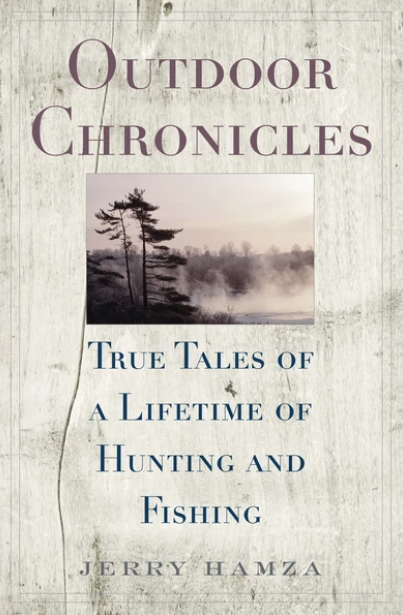 This book is a collection of outdoor stories wrapped in the human condition. They were written with an eye toward honesty and cynicism. They will make you laugh out loud, and you will want to carry them with you wherever you go. If this book goes missing, it’s a sure thing that, when you do find it, it will be in the possession of a member of your household, regardless of their interest in casting a fly. The stories cover the gamut from a fishing trip to northern Canada to a little stream that was actually better than remembered, to how the baby boomers almost trampled a sport to death, to a solitary trek along railroad tracks during a cold, dark, and dreary February, and many more. Buy Now
This book is a collection of outdoor stories wrapped in the human condition. They were written with an eye toward honesty and cynicism. They will make you laugh out loud, and you will want to carry them with you wherever you go. If this book goes missing, it’s a sure thing that, when you do find it, it will be in the possession of a member of your household, regardless of their interest in casting a fly. The stories cover the gamut from a fishing trip to northern Canada to a little stream that was actually better than remembered, to how the baby boomers almost trampled a sport to death, to a solitary trek along railroad tracks during a cold, dark, and dreary February, and many more. Buy Now

